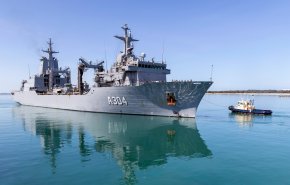A Hobart is a platform with systems. It can protect itself and other ships from missiles and air (ESSM and SM-2], detect and engage submarines (with helicopter and torpedoes) it can detect and engage other ships (with Harpoon) and it can attack land now (with Harpoon). It is planned to operate in a task force possibly without the support of air cover. What’s not to like (if it needs to go to war now)? It only has 48 VLS cells, old Aegis (no BMD) no long range SAM, it only has 8 (old small short range) missiles for surface and land attack, but (on paper) it is still vastly more capable than the ships it replaced and equal to, or much better than, the ANZACs at nearly everything a warship can be expected to do. How can you improve the existing platform before planned refit? One way is to increase the very limited land attack capability.One needs to remember that the ADF should have other options for the delivery of a land attack capability, depending on what the target is and where it is located. With the right RAAF aircraft and PGM's, an aerial strike package could potentially be launched at targets in the Sulu Sea from Darwin without needing in-flight refueling. Add in in-flight refueling and that strike distance can get extended quite a bit further. If a system like Rapid Dragon were adopted, particularly for the C-17, then Hainan could potentially be targeted by aircraft operating from Darwin.
The above is part of the reason why I mentioned in another post about the need to consider the what a warfighting system needs or can do, rather than focusing on what a specific or individual platform can do.
The system ordered for the RAN is Tomahawk. That will increase the RAN land attack range by a factor of about 10 and the possible magazine size of land attack missiles by a factor of 6 (5 ish if you count the 8 harpoons or 4ish if you preserve 16 cells for air defence) The warheads of the ordered missiles is double that of Harpoon.
We don’t know the mission the capability is required for or how many Tomahawks would be carried. There are good political and domestic reasons for that (outside scope of thread) but we can take your two missions. 1. Attack well defended targets in mainland Asia and 2. attack targets within 2000 km of RAAF bases.
I assume in both cases the mission is in concert with allies (otherwise it would be suicidal and does not merit further consideration).
Take the mainland Asian target first. Your suggestion, if I understand correctly, is to use one of 8 c-17s with (not ordered Rapid Dragon) to attack it. I like Rapid Dragon (for other missions) but I don’t think any surviving C-17 would get to fly close enough to launch those missiles until many days after other weapons had attacked that target extensively. Until it does launch the RAAF has to preserve that asset and its escorts, bases and refuelling aircraft. if C-17s in continental Australia are a credible threat then they will be targeted (and the minimal planned Australian air defences will have plenty of other targets to protect).
Hobart does have a theoretical capability to defend itself against cruise missiles, aircraft and submarines and can stay at sea for weeks. It can theoretically be defended by allies against ballistic missiles (which may themselves have targeting difficulties - nobody knows who comes out better from the cyber and satellite war). Hobart might be expected to rotate into the Tomahawk firing line with lots of other Aegis equipped ships from various nations. The US is building more Burkes, buying and updating Tomahawks, but no more C-17s. Sounds like B2(1), other stuff, then lots of Tomahawk for that target from their end. I am not advocating that mission for Australia but I am saying Tomahawk equipped Hobart is the only choice if that is the mission (Australia has rejected pursuing B21).
For the mission within 2000km of airbases I agree with you that Australia should have options. If one of the options is to launch missiles from a ship (that can also protect itself and perhaps in some circs protect the airbase) under RAAF air cover without risking RAAF aircrew (including refuellers) then that option is appealing to me (I have an open mind about the arguments around observability and targeting).





